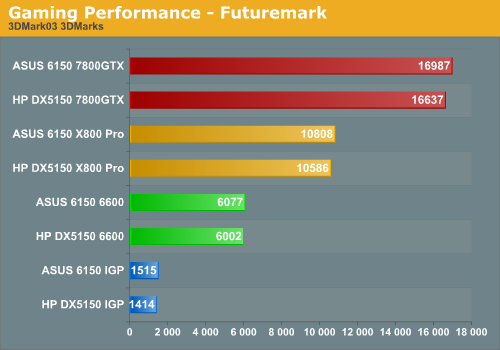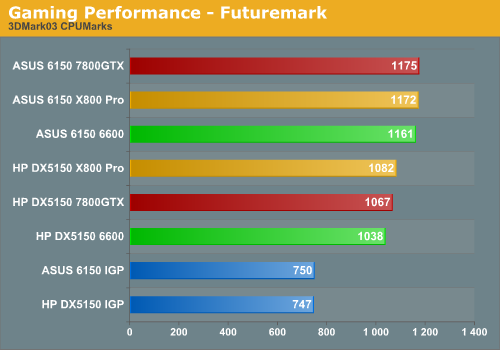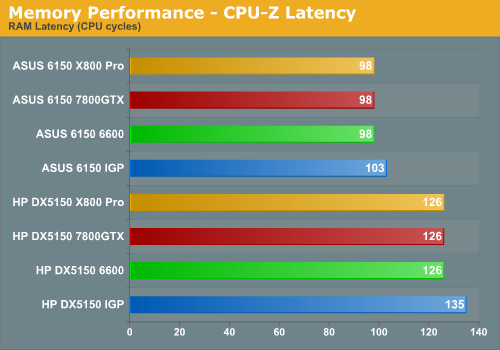Synthetic Benchmarks
We'll wrap up our performance benchmarking with a couple of less important metrics. Futuremark has been making 3DMark for over six years, and many people refer to it to see how a system will perform in games. We have always preferred real world gaming benchmarks, though it's difficult to come up with repeatable tests for certain genres. We also included the memory latency, as measured by CPU-Z.
Going along with that last point, take a look at the memory latencies. Since both chips are running at 2.4 GHz, we can directly compare the results without converting to nanoseconds. The HP system with its CL3 RAM ends up having 28% higher latencies, which explains why it consistently gets beat by the ASUS system with the slightly slower processor. Also somewhat interesting is that the IGP solutions both have higher memory latencies, showing that the shared memory architecture does have an impact on performance.
We'll wrap up our performance benchmarking with a couple of less important metrics. Futuremark has been making 3DMark for over six years, and many people refer to it to see how a system will perform in games. We have always preferred real world gaming benchmarks, though it's difficult to come up with repeatable tests for certain genres. We also included the memory latency, as measured by CPU-Z.





Going along with that last point, take a look at the memory latencies. Since both chips are running at 2.4 GHz, we can directly compare the results without converting to nanoseconds. The HP system with its CL3 RAM ends up having 28% higher latencies, which explains why it consistently gets beat by the ASUS system with the slightly slower processor. Also somewhat interesting is that the IGP solutions both have higher memory latencies, showing that the shared memory architecture does have an impact on performance.










48 Comments
View All Comments
gibhunter - Wednesday, December 14, 2005 - link
That's not an X2 3800+. It's the standard 2.4GHZ 3800+ single core.Regarding these HPs, I have a few of these at work. They are realy great. For $500 and change you get an Athlon 64, 512MB of ram and a WinXP Pro. Try and put a system like that yourself and you'll spend just as much or more and that's not counting the snazzy keyboard and mouse that comes with that system. It really is a good deal.
JarredWalton - Thursday, December 15, 2005 - link
Just to reiterate, the linked 3800+ is indeed an X2:"We actually have an X2 3800+ Smart Buy, sku # pz635ua#aba....it might be
listed incorrectly as a 3800+, but it's an X2. I'm in the process of
getting that fixed."
That's from an HP representative, one of the marketing managers of the small-business division.
Googer - Thursday, December 15, 2005 - link
Equally impressive for the $500-ish range is this http://e4me.com/products/products.html?prod=eMachi...">e-machineLoneWolf15 - Thursday, December 15, 2005 - link
If you're a business, e-Machines isn't equally impressive. Part of what you are paying for is the support. The system reviewed carries a three-year warranty (par for the course on business systems) and probably carries business-level support too. Most HP systems also use a fair number of brand-name parts (i.e., ASUS mainboards in most systems). I don't deny that eMachines has its place, but it comes nowhere near something that HP puts out.P.S. While I like most of HP's system configurations, even home ones, I haven't heard good things about home-level support. And one other thing, Jared...why does the article say this system has a Clawhammer core CPU? I thought Clawhammers went the way of the dinosaur on Socket 939 long ago. Anything this new ought to have a Venice or San Diego core chip in it.
JarredWalton - Thursday, December 15, 2005 - link
Well, it does have a ClawHammer -- at least the system I have does. You have to remember that AMD only has one fab producing 90 nm parts, and they have an old fab that still produces 130 nm parts. Perhaps AMD gives them a better deal on the older chips? Or perhaps it's just that this model was made a little while ago? If it had used a San Diego core, I expect power draw would have dropped another 20 W at least.mino - Saturday, December 17, 2005 - link
You are wrong on this. AMD publicly stated sometime in the Q2 that they have converted all of their lines onto 90nm production.Also AMD does have only one fab - FAB30 - currently in producing CPU's. While there is FAB25 it produces flash and is part of Spansion division and there is also FAB35(or 36?) in qualification process the only fab producing AMD CPU's in volume is currently FAB30 on 200mm wafers.
JarredWalton - Friday, December 23, 2005 - link
Hmm... obviously I'm not paying close enough attention to AMD's fabs. I could have sworn they still had a 130nm fab making CPUs. I would have thought 130nm would be sufficient for a lot of stuff - better to keep what you have running instead of retrofitting old fabs, right? Then again, new fabs are getting more and more expensive.mino - Sunday, January 1, 2006 - link
Well, Austin FAB25 was not suitable nor meant for smaller than 180nm process (for logic products). AMD thus made a cash cow out of it during hard AthlonXP times. Also the capacity of any FAB is measured in wafers/time not chips pre time. In other words AMD could make twice as many K8 CPU's on 90nm than on 130nm. Couple that with huge capacity constraints AMD faced in 2005 and fact they had only one 200mm FAB and it becomes clear why not to produce on 130nm. Around this time FAB35 should come online so the tight supply of the last quarter should not repeat for some time. Also AMD's 90nm SOI process is pretty good so don't expect FAB30 phase-out anytime soon(90nm is last logic process for FAB30). Shame FAB35 wasn't online in 2005, Intel would've had a way hotter year than it had.